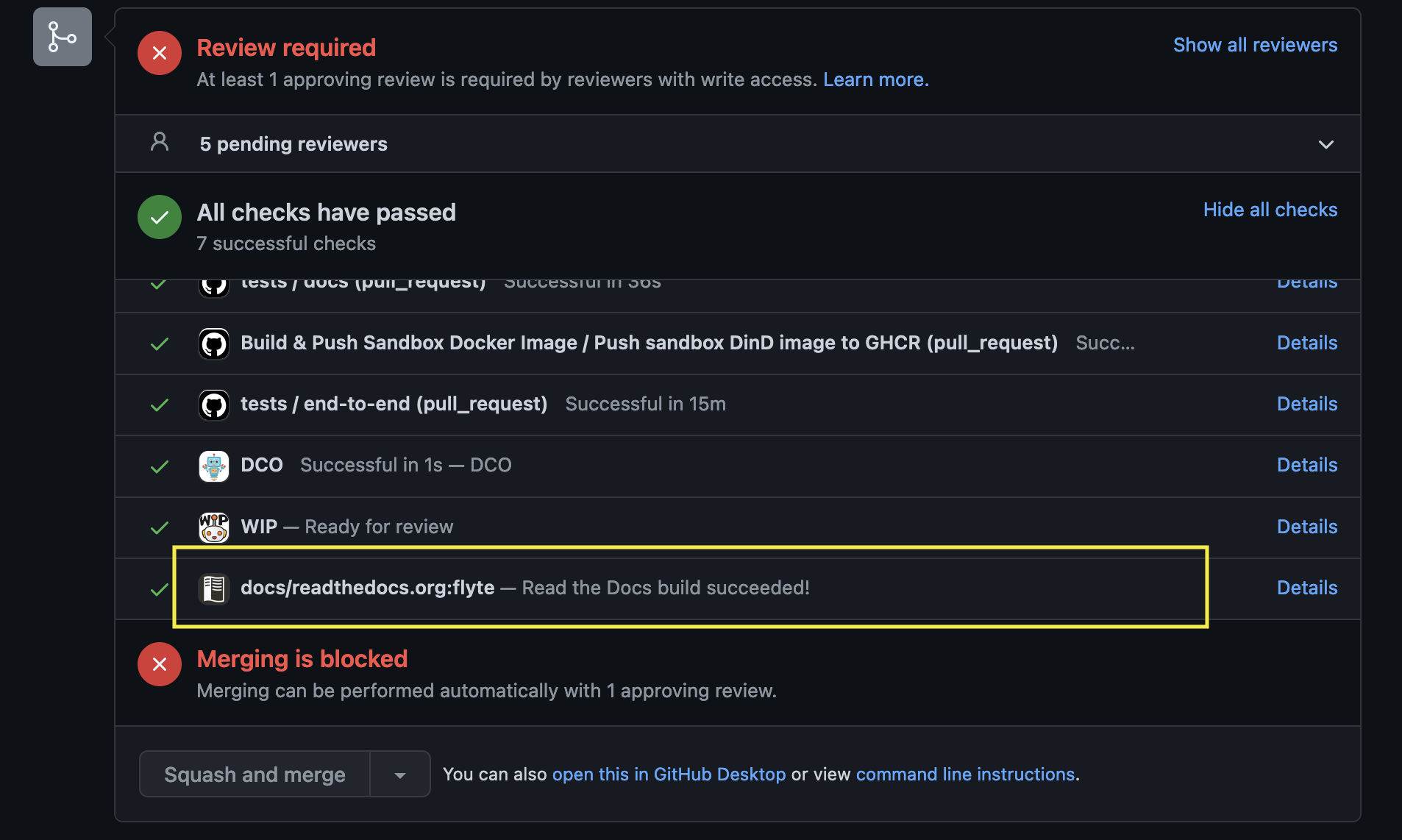Contributing to User Guide, Tutorials and Integrations#
The examples documentation provides an easy way for the community to learn about the rich set of features that Flyte offers, and we are constantly improving them with your help!
Whether you’re a novice or experienced software engineer, data scientist, or machine learning practitioner, all contributions are welcome!
How to contribute#
The Flyte documentation examples guides are broken up into three types:
User Guides: These are short, simple guides that demonstrate how to use a particular Flyte feature. The Markdown files live in the flyte repository, while the example code lives in flytesnacks. These examples should be runnable locally. Note: The comments in the user guide Python files will not be rendered as user-facing docs. To update the user-facing documentation, open a pull request in the flyte repo.
Tutorials: These are longer, more advanced guides that use multiple Flyte features to solve real-world problems. Tutorials are generally more complex examples that may require extra setup or that can only run on larger clusters.
Integrations: These examples showcase how to use the Flyte plugins that integrate with the broader data and ML ecosystem.
The first step to contributing an example is to open up a documentation issue to articulate the kind of example you want to write. The Flyte maintainers will guide and help you figure out where your example would fit best.
Creating an example#
Prerequisites
Follow the Environment setup guide to get your development environment ready.
The flytesnacks repo examples live in the examples directory, where each
subdirectory contains a self-contained example project that covers a particular
feature, integration, or use case.
examples
├── README.md
├── airflow_plugin
├── athena_plugin
├── aws_batch_plugin
├── basics
├── bigquery_plugin
...
Adding an example script to an existing project#
If you’re adding a new example to an existing project, you can simply create a
new .py file in the appropriate directory. For example, if you want to add a new
example in the examples/basics project, simply do:
touch examples/basics/my_new_example.py
If you are creating a new user guide example, you can reference the code in the user guide documentation using the rli (remoteliteralinclude) directive.
If you are creating a new integration or tutorial example, add the example to the README.md file of the
example project as an entry in the auto-examples-toc directive:
```{auto-examples-toc}
...
my_new_example
```
Creating a new example project#
Important
If you’re creating a new example in the User Guide, Tutorials, or Integrations that doesn’t fit into any of the existing subdirectories, you’ll need to setup a new example project.
In the flytesnacks root directory, create one with:
./scripts/create-example-project new_example_project
This will create a new directory under examples:
examples/new_example_project
├── Dockerfile
├── README.md
├── new_example_project
│ ├── __init__.py
│ └── example.py
├── requirements.in
└── requirements.txt
Creating python examples#
User guide examples#
If you are writing a user guide example, write your example Python script in regular Python, with regular comments. These comments will not be extracted from the Python file and turned into user-facing documentation. To update user-facing user guide documentation, edit the user guide files in the flyte repository. You can use the rli (remoteliteralinclude) directive to include snippets of code from your example Python file.
Tutorial or integration examples#
If you are writing a tutorial or integration example, write your example Python script in percent format,
which allows you to interleave python code and markdown in the same file. Each
code cell should be delimited by # %%, and each markdown cell should be
delimited with # %% [markdown].
# %%
print("Hello World!")
# %% [markdown]
# This is a markdown cell
# %%
print("This is another code cell")
Markdown cells have access to sphinx directives through the
myst markdown format,
which is a flavor of markdown that makes it easier to write documentation while
giving you the utilities of sphinx. flytesnacks uses the
myst-nb and
jupytext packages to interpret the
python files as rst-compatible files.
Writing examples: explain what the code does#
Following the literate programming paradigm, make sure to
interleave explanations in the *.py files containing the code example.
A Simple Example
Here’s a code snippet that defines a function that takes two positional arguments and one keyword argument:
def function(x, y, z=3):
return x + y * z
As you can see, function adds the two first arguments and multiplies the sum with the third keyword
argument. Can you think of a better name for this function?
Explanations don’t have to be this detailed for such a simple example, but you can imagine how this makes for a better reading experience for more complicated examples.
Creating examples in other formats#
Writing examples in .py files is preferred since they are easily tested and
packaged, but flytesnacks also supports examples written in .ipynb and
.md files in myst markdown format. This is useful in the following cases:
.ipynb: When a.pyexample needs a companion jupyter notebook as a task, e.g. to illustrate the use ofNotebookTasks, or when an example is intended to be run from a notebook..md: When a piece of documentation doesn’t require testable or packaged flyte tasks/workflows, an example page can be written as a myst markdown file.
Note: If you want to add Markdown files to a user guide example project, add them to the flyte repository instead.
Writing a README#
The README.md file needs to capture the what, why, and how of the example.
What is the integration about? Its features, etc.
Why do we need this integration? How is it going to benefit the Flyte users?
Showcase the uniqueness of the integration
How to install the plugin?
Finally, for tutorials and integrations only, write a auto-examples-toc directive at the bottom of the file:
```{auto-examples-toc}
example_01
example_02
example_03
```
Where example_01, example_02, and example_03 are the python module
names of the examples under the new_example_project directory. These can also
be the names of the .ipynb or .md files (but without the file extension).
Tip
Refer to any subdirectory in the examples directory
Test your code#
If the example code can be run locally, just use python <my_file>.py to run it.
Testing on a cluster#
Install flytectl, the commandline interface for flyte.
Note
Learn more about installation and configuration of Flytectl here.
Start a Flyte demo cluster with:
flytectl demo start
Testing the basics project examples on a local demo cluster#
In this example, we’ll build the basics project:
# from flytesnacks root directory
cd examples/basics
Build the container:
docker build . --tag "basics:v1" -f Dockerfile
Package the examples by running:
pyflyte --pkgs basics package --image basics:v1 -f
Register the examples by running
flytectl register files \
-p flytesnacks \
-d development \
--archive flyte-package.tgz \
--version v1
Visit https://localhost:30081/console to view the Flyte console, which consists
of the examples present in the flytesnacks/core directory.
Updating dependencies#
If you’ve updated the dependencies of the project, update the requirements.txt
file by running:
pip-compile requirements.in --upgrade --verbose --resolver=backtracking
Rebuild the image#
If you’ve updated the source code or dependencies of the project, and rebuild the image with:
docker build . --tag "basics:v2" -f core/Dockerfile
pyflyte --pkgs basics package --image basics:v2 -f
flytectl register files \
-p flytesnacks \
-d development \
--archive flyte-package.tgz \
--version v2
Refer to this guide if the code in itself is updated and requirements.txt is the same.
Pre-commit hooks#
We use pre-commit to automate linting and code formatting on every commit. Configured hooks include black, isort, flake8 and linters to ensure newlines are added to the end of files, and there is proper spacing in files.
We run all those hooks in CI, but if you want to run them locally on every commit, run pre-commit install after
installing the dev environment requirements. In case you want to disable pre-commit hooks locally, run
pre-commit uninstall. More info here.
Formatting#
We use black and isort to autoformat code. They
are configured as git hooks in pre-commit. Run make fmt to format your code.
Spell-checking#
We use codespell to catch common misspellings. Run
make spellcheck to spell-check the changes.
Update Documentation Pages#
The docs/conf.py contains the sphinx configuration for building the
flytesnacks documentation.
At build-time, the flytesnacks sphinx build system will convert all of the
projects in the examples directory into docs/auto_examples, and will be
available in the documentation.
Important
The docs build system will convert the README.md files in each example
project into a index.md file, so you can reference the root page of each
example project, e.g., in myst markdown format, you can write a table-of-content
directive like so:
```{toc}
auto_examples/basics/index
```
If you’ve created a new example project, you’ll need to add the index page
in the table of contents in docs/index.md to make sure the project
shows up in the documentation. Additonally, you’ll need to update the appropriate
list-table directive in docs/userguide.md, docs/tutorials.md, or
docs/integrations.md so that it shows up in the respective section of the
documentation.
Build the documentation locally#
Verify that the code and documentation look as expected:
Learn about the documentation tools here
Install the requirements by running
pip install -r docs-requirements.txt.Run
make -C docs htmlTip
To run a fresh build, run
make -C docs clean html.Open the HTML pages present in the
docs/_builddirectory in the browser withopen docs/_build/index.html
Create a pull request#
Create the pull request, then ensure that the docs are rendered correctly by clicking on the documentation check.

You can refer to this PR for the exact changes required.
